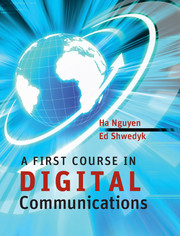Book contents
- Frontmatter
- Contents
- Preface
- Acknowledgements
- Abbreviations
- 1 Introduction
- 2 Deterministic signal characterization and analysis
- 3 Probability theory, random variables and random processes
- 4 Sampling and quantization
- 5 Optimum receiver for binary data transmission
- 6 Baseband data transmission
- 7 Basic digital passband modulation
- 8 M-ary signaling techniques
- 9 Signaling over bandlimited channels
- 10 Signaling over fading channels
- 11 Advanced modulation techniques
- 12 Synchronization
- Index
6 - Baseband data transmission
Published online by Cambridge University Press: 05 June 2012
- Frontmatter
- Contents
- Preface
- Acknowledgements
- Abbreviations
- 1 Introduction
- 2 Deterministic signal characterization and analysis
- 3 Probability theory, random variables and random processes
- 4 Sampling and quantization
- 5 Optimum receiver for binary data transmission
- 6 Baseband data transmission
- 7 Basic digital passband modulation
- 8 M-ary signaling techniques
- 9 Signaling over bandlimited channels
- 10 Signaling over fading channels
- 11 Advanced modulation techniques
- 12 Synchronization
- Index
Summary
Introduction
As pointed out in the previous chapter, binary digits (or bits) “0” and “1” are used simply to represent the information content. They are abstract (intangible) quantities and need to be converted into electrical waveforms for effective transmission or storage. How to perform such a conversion is generally governed by many factors, of which the most important one is the available transmission bandwidth of the communication channel or the storage media.
In baseband data transmission, the bits are mapped into two voltage levels for direct transmission without any frequency translation. Such a baseband data transmission is applicable to cable systems (both metallic and fiber optics) since the transmission bandwidth of most cable systems is in the baseband. Various baseband signaling techniques, also known as line codes, have been developed to satisfy a number of criteria. Typical criteria are:
(i) Signal interference and noise immunity Depending on the signal sets, certain signaling schemes exhibit superior performance in the presence of noise as reflected by the probability of bit error.
(ii) Signal spectrum Typically one would like the transmitted signal to occupy as small a frequency band as possible. For baseband signaling, this implies a lack of high-frequency components. However, it is sometimes also important to have no DC component. Having a signaling scheme which does not have a DC component implies that AC coupling via a transformer may be used in the transmission channel.
(iii) […]
- Type
- Chapter
- Information
- A First Course in Digital Communications , pp. 231 - 262Publisher: Cambridge University PressPrint publication year: 2009

